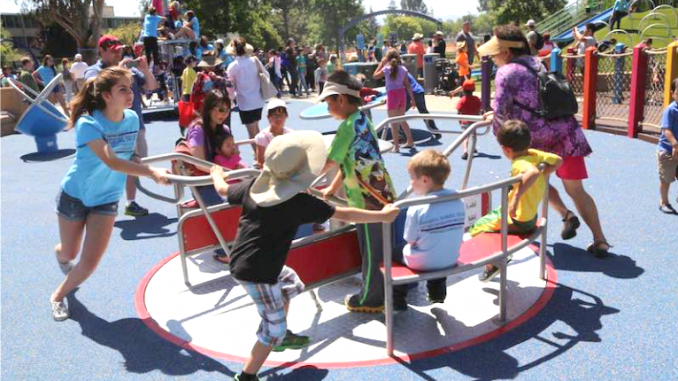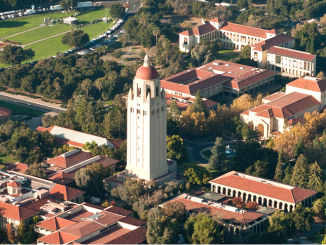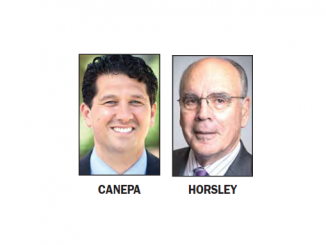
The Magical Bridge Playground in Mitchell Park, part of the Palo Alto Parks and Recreation Department. Photo from the department’s master plan.
By Elaine Goodman
Daily Post Correspondent
A large percentage of residents surveyed said they want restrooms in more of Palo Alto’s parks — but some might have a different viewpoint if the park in question is close to their home.
Adding restrooms to as many as seven Palo Alto parks is one recommendation of a parks and recreation master plan that the City Council approved Sept. 11. The master plan will guide development of the city’s parks, trails and open space over the next 20 years.
One way that the city gathered feedback while developing the parks plan was through an online survey in November 2014. Eighty-one percent of respondents said restrooms would be an important or very important improvement to the city’s parks.
“It was overwhelming, actually, people wanted more bathrooms,” Community Services Director Rob de Geus said during last week’s council meeting, in response to a question from Councilwoman Liz Kniss. “What’s been difficult is when you talk about bathrooms with a specific neighborhood.”
“They may not always want it in their park,” Kniss added.
Seven parks
The seven parks identified as potential sites for new restrooms are Bol Park, Bowden Park, Eleanor Pardee Park, Johnson Park, Ramos Park, Robles Park and Terman Park. De Geus said the city would talk with surrounding neighborhoods before deciding to move forward with restrooms at a particular park.
The seven parks were selected because they are all 2 acres or larger; have amenities that encourage visitors to stay in the park for longer times; are used heavily; and lack nearby restrooms. Fourteen city parks already have restrooms.
Resident Bob Moss told the council that restrooms aren’t needed at Terman Park because nearby Terman Middle School usually leaves its restrooms open for the public to use.
As for Bol Park, Moss said when it was created nearly 40 years ago, the intent was for it to remain a rural environment with few amenities.
“Restrooms were discussed; we explicitly determined not to put restrooms in Bol Park,” Moss said.
Aram James said he walks at Palo Alto parks for 70 to 90 minutes at a time.
“I have to admit, sometimes I have to get back in my car and go find a bathroom during that hike, and come back,” James said, noting that the extra driving contributes to air pollution.
James recalled the community’s concerns when restrooms were added to Juana Briones Park.
“There was a lot of fear that unhoused members of our community would be sleeping in the park to use the restroom,” he said. “That was mean-spirited and didn’t prove to be true.”
“What if unhoused people needed to use those bathrooms?” James added. “Would that be a bad thing? No, it would not.”
Security
The parks master plan proposes equipping the restrooms with security measures such as automatic locking doors and lighting.
The parks master plan includes a wide range of projects, from building new restrooms, dog parks, and community gardens to deciding how to use 7.7 acres recently added to Foothills Park.
One goal of the plan is to partner with the Palo Alto Unified School District to make school facilities such as tennis courts and swimming pools available to the public when school is not in session. Another goal is to add more parkland, by acquiring land or even by building parks on top of parking structures.
A major question is how to pay for the improvements outlined in the plan.
The council directed the Parks and Recreation Commission to look at potential funding sources.
Mayor Greg Scharff pointed specifically to a ballot initiative as a possible source of funding — an idea he also floated when the council discussed the parks plan back in May. With approval from two-thirds of voters, the city could increase the property tax and use the money for capital improvements at parks, but not for maintenance or operations.
Naming rights?
Councilman Greg Tanaka said the city could explore selling naming rights to some of its facilities, a move that raised millions of dollars for the city of San Diego.
Tanaka also wanted to look at increasing fees charged to non-resident users of the city’s recreation facilities, to whatever level the market can bear. The money would be used to pay for park improvements.
Some other funding ideas listed in the parks master plan include increasing developer fees or pursuing additional donations or grants.
As part of the approval of the master plan, the council also put in place new policies regarding private use of the city’s parks. That became an issue after Palantir, a downtown Palo Alto-based company, took over more than half of the soccer field at the Cubberley Community Center for two weeks in May for company parties.
Under the new policy, private organizations’ use of a city park will be limited to five days for events that exclude the general public. Weekends and peak hours, such as weekday evenings, won’t be available to private groups without approval from the community services director.
The new policies don’t apply to the Palo Alto Golf Course, where the city would actually like to see more private events to raise money for the facility.



